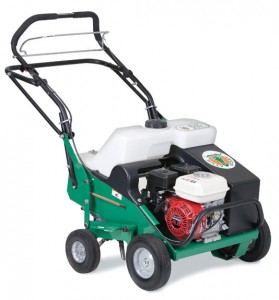 Why has Billy Goat moved from drum aerators to reciprocating designs? Over years of testing, they found that reciprocating aeration delivers huge productivity benefits. Upgrading to one of these aerators doesn’t just cut job times, it delivers better results and reduces maintenance, helping your bottom line.
Why has Billy Goat moved from drum aerators to reciprocating designs? Over years of testing, they found that reciprocating aeration delivers huge productivity benefits. Upgrading to one of these aerators doesn’t just cut job times, it delivers better results and reduces maintenance, helping your bottom line.
Drum Aerators: A Proven Design with Some Major Problems
This type of aerator uses a heavy roller with tines bolted onto the exterior or built into a mechanism to fold out when needed. The roller’s weight to push tines into the ground, limiting hole density of 4-6 holes per square foot. Walk-behind models can be rolled back and forth in the ground to cut more holes in the turf, while stand-on models have to make several passes to fully relieve ground compaction.
Using a drum aerator is awkward. Tines should be disengaged to let the roller move freely for tuning, but since this is difficult, most landscapers simply lift and spin the unit, letting the tines drag against the ground and damage the turf. Manufacturers have come up with solutions including support wheels and split drive systems to make turning easier, but this adds cost and doesn’t completely eliminate the problem.
For large spaces, there are towable aerators like Billy Goat’s AET60. By mounting the tines on swiveling assemblies and using the towing tractor’s three-point hitch to lift the unit when turning, most of the turf damage problems are eliminated. Unfortunately, there’s no way to adapt this design to a machine that is small enough to be used on suburban lawns.
No matter the design, drum aerators are very sensitive to soil moisture. If the soil is too dry, the tines will ride over compacted soil instead of punching into it. If it’s too wet, the weight of the roller can increase compaction, making drainage problems even worse
Reciprocating Aerators: Addressing Issues Head On with Modern Design
Instead of relying on weight, reciprocating aerators use mechanical force, using an engine to drive a cam that pushes the tines into the soil. This allows the tines to cut repeatedly as the aerator is rolled along, getting a hole density with one pass that would require several passes with a drum aerator. Billy Goat took this design a step further with their AE1300H. It has a Variable Aeration Density (VAD) system which controls the speed of the cam, letting it make twice to 10 times as many holes as a drum aerator. This relieves soil compaction with the minimal amount of holes, which means fewer core plugs to clean up.
All reciprocating aerators are lighter than their drum counterparts, reduces compaction. The cam drive also uses fewer tines and makes it easy to disengage, eliminating turf damage when turning.
Soil still needs to be moist, but issues with compaction or penetration are far less likely, getting good results even when the ground isn’t perfectly saturated.
The added density and control don’t just make jobs easier, they greatly decrease operating costs. On average, a reciprocating aerator can get small jobs done in half the time of a walk-behind drum aerator. For larger jobs, adding a chariot or a sulky can give a walk-behind similar performance to a small ride-on drum aerator with a lower upfront cost. Since a reciprocating design doesn’t need side wheels, the unit can be narrow enough to pass through gates without sacrificing performance.
With four or 8 tines to service instead of 30 to 40, cleanup is faster and repairs are less costly. This design also keeps the tines visible, making it easier to avoid sprinkler heads, rocks, and other objects.
Keeping Your Modern Machine Ready to Work
If you’re making the switch to a reciprocating aerator, getting replacement parts is as simple as using your browser. Billygoatparts.com is a certified dealer for Billy Goat and their manufacturing partners, letting us offer a complete line of parts for their equipment and the engines that power them. Our site has built in parts diagrams and descriptions to make it easy to find what you need, and we can ship your order to any location in the U.S. or Canada.
